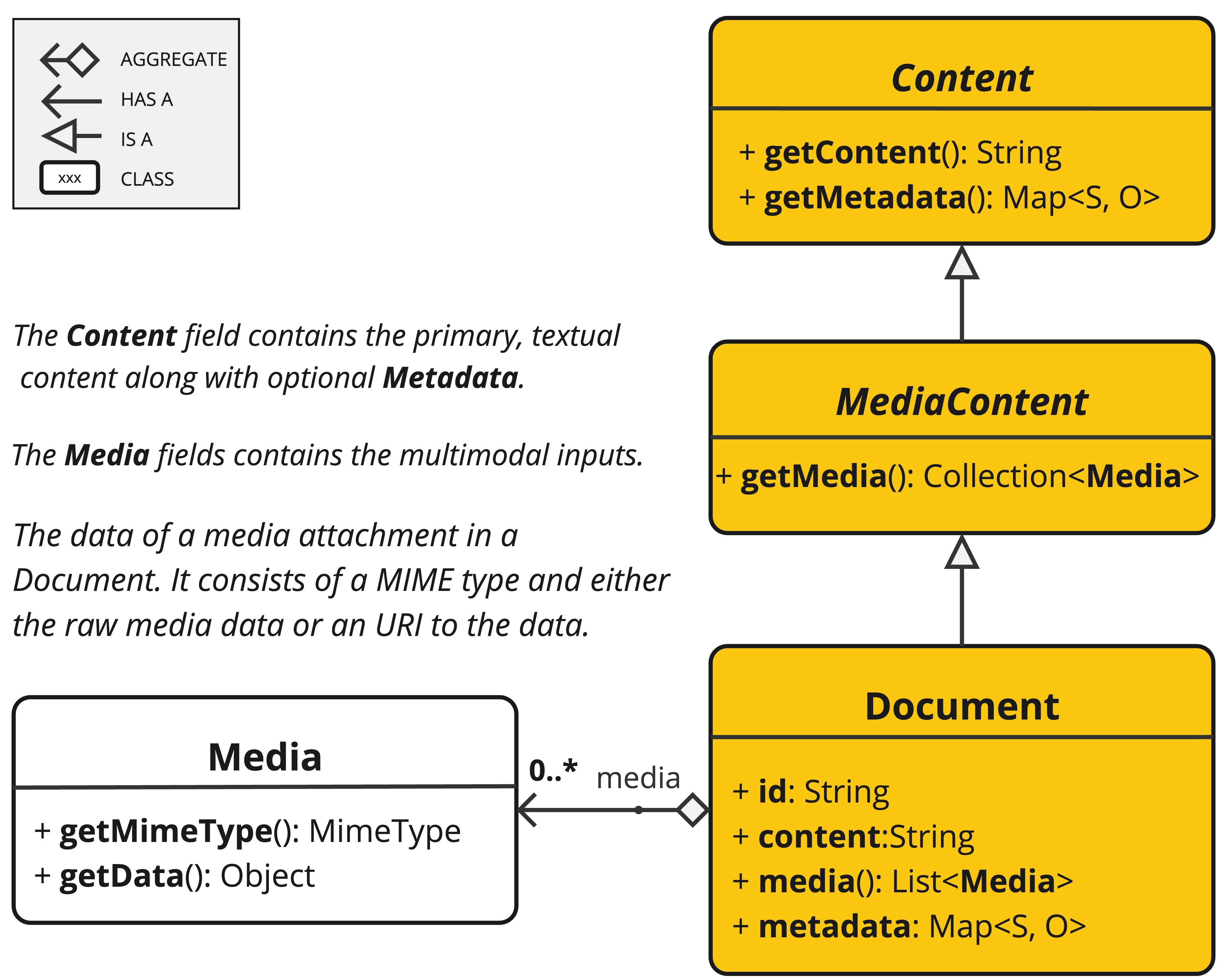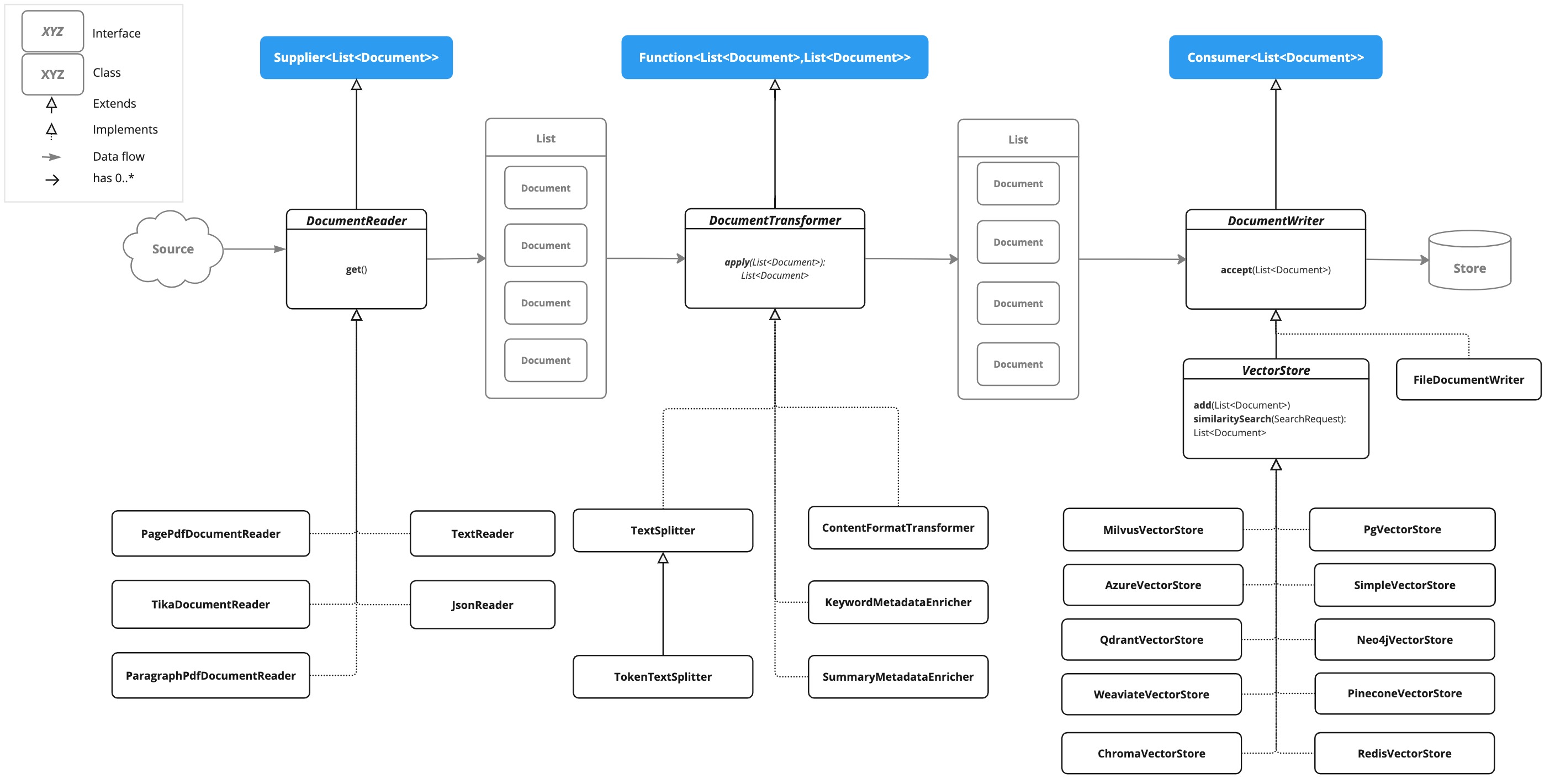ETL 管道
提取、转换和加载 (ETL) 框架是检索增强生成 (RAG) 用例中数据处理的支柱。
ETL 管道协调从原始数据源到结构化向量存储的数据流,确保数据以最佳格式供 AI 模型检索。
RAG 用例是通过从数据主体中检索相关信息来增强生成模型能力的文本,以提高生成输出的质量和相关性。
API 概览
ETL 管道创建、转换和存储 Document 实例。

Document 类包含文本、元数据以及可选的额外媒体类型,如图片、音频和视频。
ETL 管道有三个主要组件:
-
实现
Supplier<List<Document>>的DocumentReader -
实现
Function<List<Document>, List<Document>>的DocumentTransformer -
实现
Consumer<List<Document>>的DocumentWriter
借助 DocumentReader,可以从 PDF、文本文件和其他文档类型创建 Document 类的内容。
要构建一个简单的 ETL 管道,可以将每种类型的一个实例链式连接起来。

假设我们有以下这三种 ETL 类型的实例:
-
PagePdfDocumentReader,一个DocumentReader的实现。 -
TokenTextSplitter,一个DocumentTransformer的实现。 -
VectorStore,一个DocumentWriter的实现。
要执行将数据加载到向量数据库中用于检索增强生成模式的基本操作,可以使用以下 Java 函数式语法代码。
vectorStore.accept(tokenTextSplitter.apply(pdfReader.get()));或者,您可以使用在该领域更自然地表达的方法名称。
vectorStore.write(tokenTextSplitter.split(pdfReader.read()));ETL 接口
ETL 管道由以下接口和实现组成。ETL 类图的详细信息显示在 ETL 类图 部分。
DocumentReader
提供来自不同来源的文档源。
public interface DocumentReader extends Supplier<List<Document>> {
default List<Document> read() {
return get();
}
}DocumentTransformer
作为处理工作流的一部分转换一批文档。
public interface DocumentTransformer extends Function<List<Document>, List<Document>> {
default List<Document> transform(List<Document> transform) {
return apply(transform);
}
}DocumentReaders
JSON
JsonReader 处理 JSON 文档,将它们转换为 Document 对象列表。
示例
@Component
class MyJsonReader {
private final Resource resource;
MyJsonReader(@Value("classpath:bikes.json") Resource resource) {
this.resource = resource;
}
List<Document> loadJsonAsDocuments() {
JsonReader jsonReader = new JsonReader(this.resource, "description", "content");
return jsonReader.get();
}
}构造函数选项
JsonReader 提供了几种构造函数选项:
-
JsonReader(Resource resource) -
JsonReader(Resource resource, String… jsonKeysToUse) -
JsonReader(Resource resource, JsonMetadataGenerator jsonMetadataGenerator, String… jsonKeysToUse)
参数
-
resource: 指向 JSON 文件的 SpringResource对象。 -
jsonKeysToUse: JSON 中的键数组,应将其用作生成的Document对象的文本内容。 -
jsonMetadataGenerator: 可选的JsonMetadataGenerator,用于为每个Document创建元数据。
行为
JsonReader 按如下方式处理 JSON 内容:
-
它可以处理 JSON 数组和单个 JSON 对象。
-
对于每个 JSON 对象(无论是数组中的还是单个对象):
-
它根据指定的
jsonKeysToUse提取内容。 -
如果未指定键,则使用整个 JSON 对象作为内容。
-
它使用提供的
JsonMetadataGenerator(如果未提供,则使用空的)生成元数据。 -
它使用提取的内容和元数据创建
Document对象。
-
使用 JSON Pointers
JsonReader 现在支持使用 JSON Pointers 检索 JSON 文档的特定部分。此功能允许您轻松从复杂的 JSON 结构中提取嵌套数据。
示例 JSON 结构
[
{
"id": 1,
"brand": "Trek",
"description": "A high-performance mountain bike for trail riding."
},
{
"id": 2,
"brand": "Cannondale",
"description": "An aerodynamic road bike for racing enthusiasts."
}
]在此示例中,如果 JsonReader 使用 `"description"` 作为 jsonKeysToUse 进行配置,它将创建 Document 对象,其中内容是数组中每辆自行车的 "description" 字段的值。
文本
TextReader 处理纯文本文档,将它们转换为 Document 对象列表。
示例
@Component
class MyTextReader {
private final Resource resource;
MyTextReader(@Value("classpath:text-source.txt") Resource resource) {
this.resource = resource;
}
List<Document> loadText() {
TextReader textReader = new TextReader(this.resource);
textReader.getCustomMetadata().put("filename", "text-source.txt");
return textReader.read();
}
}配置
-
setCharset(Charset charset): 设置用于读取文本文件的字符集。默认为 UTF-8。 -
getCustomMetadata(): 返回一个可变映射,您可以在其中为文档添加自定义元数据。
行为
TextReader 按如下方式处理文本内容:
-
它将文本文件的全部内容读取到单个
Document对象中。 -
文件的内容成为
Document的内容。 -
元数据会自动添加到
Document中:-
charset: 用于读取文件的字符集(默认值:“UTF-8”)。 -
source: 源文本文件的文件名。
-
-
通过
getCustomMetadata()添加的任何自定义元数据都包含在Document中。
注意事项
-
TextReader将整个文件内容读取到内存中,因此可能不适用于非常大的文件。 -
如果需要将文本拆分成更小的块,读取文档后可以使用
TokenTextSplitter等文本分割器。
List<Document> documents = textReader.get();
List<Document> splitDocuments = new TokenTextSplitter().apply(this.documents);-
该读取器使用 Spring 的
Resource抽象,允许从各种来源(classpath、文件系统、URL 等)读取。 -
可以使用
getCustomMetadata()方法将自定义元数据添加到读取器创建的所有文档中。
HTML (JSoup)
JsoupDocumentReader 使用 JSoup 库处理 HTML 文档,将它们转换为 Document 对象列表。
示例
@Component
class MyHtmlReader {
private final Resource resource;
MyHtmlReader(@Value("classpath:/my-page.html") Resource resource) {
this.resource = resource;
}
List<Document> loadHtml() {
JsoupDocumentReaderConfig config = JsoupDocumentReaderConfig.builder()
.selector("article p") // Extract paragraphs within <article> tags
.charset("ISO-8859-1") // Use ISO-8859-1 encoding
.includeLinkUrls(true) // Include link URLs in metadata
.metadataTags(List.of("author", "date")) // Extract author and date meta tags
.additionalMetadata("source", "my-page.html") // Add custom metadata
.build();
JsoupDocumentReader reader = new JsoupDocumentReader(this.resource, config);
return reader.get();
}
}JsoupDocumentReaderConfig 允许您自定义 JsoupDocumentReader 的行为:
-
charset: 指定 HTML 文档的字符编码(默认为 "UTF-8")。 -
selector: 一个 JSoup CSS 选择器,用于指定从中提取文本的元素(默认为 "body")。 -
separator: 用于连接从多个选定元素中提取的文本的字符串(默认为 "\n")。 -
allElements: 如果为true,则提取<body>元素中的所有文本,忽略selector(默认为false)。 -
groupByElement: 如果为true,则为由selector匹配的每个元素创建一个单独的Document(默认为false)。 -
includeLinkUrls: 如果为true,则提取绝对链接 URL 并将它们添加到元数据中(默认为false)。 -
metadataTags: 从中提取内容的<meta>标签名称列表(默认为["description", "keywords"])。 -
additionalMetadata: 允许您向所有创建的Document对象添加自定义元数据。
示例文档:my-page.html
<!DOCTYPE html>
<html lang="en">
<head>
<meta charset="UTF-8">
<title>My Web Page</title>
<meta name="description" content="A sample web page for Spring AI">
<meta name="keywords" content="spring, ai, html, example">
<meta name="author" content="John Doe">
<meta name="date" content="2024-01-15">
<link rel="stylesheet" href="style.css">
</head>
<body>
<header>
<h1>Welcome to My Page</h1>
</header>
<nav>
<ul>
<li><a href="/">Home</a></li>
<li><a href="/about">About</a></li>
</ul>
</nav>
<article>
<h2>Main Content</h2>
<p>This is the main content of my web page.</p>
<p>It contains multiple paragraphs.</p>
<a href="https://www.example.com">External Link</a>
</article>
<footer>
<p>© 2024 John Doe</p>
</footer>
</body>
</html>行为
JsoupDocumentReader 处理 HTML 内容并根据配置创建 Document 对象:
-
selector决定哪些元素用于文本提取。 -
如果
allElements为true,则将<body>内的所有文本提取到一个单独的Document中。 -
如果
groupByElement为true,则每个与selector匹配的元素都会创建一个单独的Document。 -
如果
allElements和groupByElement都不是true,则将所有与selector匹配的元素中的文本使用separator连接起来。 -
文档标题、指定
<meta>标签中的内容以及(可选地)链接 URL 会添加到Document的元数据中。 -
用于解析相对链接的基础 URI 将从 URL 资源中提取。
读取器保留选定元素的文本内容,但删除其中的任何 HTML 标签。
Markdown
MarkdownDocumentReader 处理 Markdown 文档,将它们转换为 Document 对象列表。
示例
@Component
class MyMarkdownReader {
private final Resource resource;
MyMarkdownReader(@Value("classpath:code.md") Resource resource) {
this.resource = resource;
}
List<Document> loadMarkdown() {
MarkdownDocumentReaderConfig config = MarkdownDocumentReaderConfig.builder()
.withHorizontalRuleCreateDocument(true)
.withIncludeCodeBlock(false)
.withIncludeBlockquote(false)
.withAdditionalMetadata("filename", "code.md")
.build();
MarkdownDocumentReader reader = new MarkdownDocumentReader(this.resource, config);
return reader.get();
}
}MarkdownDocumentReaderConfig 允许您自定义 MarkdownDocumentReader 的行为:
-
horizontalRuleCreateDocument: 当设置为true时,Markdown 中的水平分割线将创建新的Document对象。 -
includeCodeBlock: 当设置为true时,代码块将包含在与周围文本相同的Document中。当为false时,代码块创建单独的Document对象。 -
includeBlockquote: 当设置为true时,引用块将包含在与周围文本相同的Document中。当为false时,引用块创建单独的Document对象。 -
additionalMetadata: 允许您向所有创建的Document对象添加自定义元数据。
示例文档:code.md
This is a Java sample application:
```java
package com.example.demo;
import org.springframework.boot.SpringApplication;
import org.springframework.boot.autoconfigure.SpringBootApplication;
@SpringBootApplication
public class DemoApplication {
public static void main(String[] args) {
SpringApplication.run(DemoApplication.class, args);
}
}
```
Markdown also provides the possibility to `use inline code formatting throughout` the entire sentence.
---
Another possibility is to set block code without specific highlighting:
```
./mvnw spring-javaformat:apply
```行为:MarkdownDocumentReader 处理 Markdown 内容并根据配置创建 Document 对象:
-
标题成为
Document对象中的元数据。 -
段落成为
Document对象的内容。 -
代码块可以分离到它们自己的
Document对象中,或包含在周围的文本中。 -
引用块可以分离到它们自己的
Document对象中,或包含在周围的文本中。 -
水平分割线可用于将内容拆分成单独的
Document对象。
读取器保留内联代码、列表和文本样式等格式,这些格式位于 Document 对象的内容中。
PDF 页面
PagePdfDocumentReader 使用 Apache PdfBox 库解析 PDF 文档。
使用 Maven 或 Gradle 将依赖项添加到您的项目。
<dependency>
<groupId>org.springframework.ai</groupId>
<artifactId>spring-ai-pdf-document-reader</artifactId>
</dependency>或添加到您的 Gradle build.gradle 构建文件中。
dependencies {
implementation 'org.springframework.ai:spring-ai-pdf-document-reader'
}示例
@Component
public class MyPagePdfDocumentReader {
List<Document> getDocsFromPdf() {
PagePdfDocumentReader pdfReader = new PagePdfDocumentReader("classpath:/sample1.pdf",
PdfDocumentReaderConfig.builder()
.withPageTopMargin(0)
.withPageExtractedTextFormatter(ExtractedTextFormatter.builder()
.withNumberOfTopTextLinesToDelete(0)
.build())
.withPagesPerDocument(1)
.build());
return pdfReader.read();
}
}PDF 段落
ParagraphPdfDocumentReader 使用 PDF 目录(例如 TOC)信息将输入 PDF 拆分为文本段落,并为每个段落输出一个单独的 Document。注意:并非所有 PDF 文档都包含 PDF 目录。
依赖项
使用 Maven 或 Gradle 将依赖项添加到您的项目。
<dependency>
<groupId>org.springframework.ai</groupId>
<artifactId>spring-ai-pdf-document-reader</artifactId>
</dependency>或添加到您的 Gradle build.gradle 构建文件中。
dependencies {
implementation 'org.springframework.ai:spring-ai-pdf-document-reader'
}示例
@Component
public class MyPagePdfDocumentReader {
List<Document> getDocsFromPdfWithCatalog() {
ParagraphPdfDocumentReader pdfReader = new ParagraphPdfDocumentReader("classpath:/sample1.pdf",
PdfDocumentReaderConfig.builder()
.withPageTopMargin(0)
.withPageExtractedTextFormatter(ExtractedTextFormatter.builder()
.withNumberOfTopTextLinesToDelete(0)
.build())
.withPagesPerDocument(1)
.build());
return pdfReader.read();
}
}Tika (DOCX, PPTX, HTML…)
TikaDocumentReader 使用 Apache Tika 从各种文档格式(例如 PDF、DOC/DOCX、PPT/PPTX 和 HTML)中提取文本。有关支持格式的完整列表,请参阅 Tika 文档。
依赖项
<dependency>
<groupId>org.springframework.ai</groupId>
<artifactId>spring-ai-tika-document-reader</artifactId>
</dependency>或添加到您的 Gradle build.gradle 构建文件中。
dependencies {
implementation 'org.springframework.ai:spring-ai-tika-document-reader'
}示例
@Component
class MyTikaDocumentReader {
private final Resource resource;
MyTikaDocumentReader(@Value("classpath:/word-sample.docx")
Resource resource) {
this.resource = resource;
}
List<Document> loadText() {
TikaDocumentReader tikaDocumentReader = new TikaDocumentReader(this.resource);
return tikaDocumentReader.read();
}
}转换器
TokenTextSplitter
TokenTextSplitter 是 TextSplitter 的一个实现,它使用 CL100K_BASE 编码,根据 token 计数将文本分割成块。
用法
@Component
class MyTokenTextSplitter {
public List<Document> splitDocuments(List<Document> documents) {
TokenTextSplitter splitter = new TokenTextSplitter();
return splitter.apply(documents);
}
public List<Document> splitCustomized(List<Document> documents) {
TokenTextSplitter splitter = new TokenTextSplitter(1000, 400, 10, 5000, true);
return splitter.apply(documents);
}
}构造函数选项
TokenTextSplitter 提供了两种构造函数选项:
-
TokenTextSplitter(): 使用默认设置创建分割器。 -
TokenTextSplitter(int defaultChunkSize, int minChunkSizeChars, int minChunkLengthToEmbed, int maxNumChunks, boolean keepSeparator)
参数
-
defaultChunkSize: 每个文本块以 token 为单位的目标大小(默认值:800)。 -
minChunkSizeChars: 每个文本块以字符为单位的最小大小(默认值:350)。 -
minChunkLengthToEmbed: 要包含的块的最小长度(默认值:5)。 -
maxNumChunks: 从文本生成的最大块数(默认值:10000)。 -
keepSeparator: 是否在块中保留分隔符(例如换行符)(默认值:true)。
行为
TokenTextSplitter 按如下方式处理文本内容:
-
它使用 CL100K_BASE 编码将输入文本编码为 token。
-
它根据
defaultChunkSize将编码的文本拆分成块。 -
对于每个块:
-
它将块解码回文本。
-
它尝试在
minChunkSizeChars后找到一个合适的断点(句号、问号、感叹号或换行符)。 -
如果找到断点,它将在该点截断该块。
-
它修剪该块,并根据
keepSeparator设置可选地移除换行符。 -
如果结果块长于
minChunkLengthToEmbed,则将其添加到输出中。
-
-
这个过程持续到所有 token 都被处理或达到
maxNumChunks。 -
如果任何剩余文本长于
minChunkLengthToEmbed,则将其作为最终块添加。
示例
Document doc1 = new Document("This is a long piece of text that needs to be split into smaller chunks for processing.",
Map.of("source", "example.txt"));
Document doc2 = new Document("Another document with content that will be split based on token count.",
Map.of("source", "example2.txt"));
TokenTextSplitter splitter = new TokenTextSplitter();
List<Document> splitDocuments = this.splitter.apply(List.of(this.doc1, this.doc2));
for (Document doc : splitDocuments) {
System.out.println("Chunk: " + doc.getContent());
System.out.println("Metadata: " + doc.getMetadata());
}KeywordMetadataEnricher
KeywordMetadataEnricher 是一个 DocumentTransformer,它使用生成式 AI 模型从文档内容中提取关键词并将其添加为元数据。
用法
@Component
class MyKeywordEnricher {
private final ChatModel chatModel;
MyKeywordEnricher(ChatModel chatModel) {
this.chatModel = chatModel;
}
List<Document> enrichDocuments(List<Document> documents) {
KeywordMetadataEnricher enricher = new KeywordMetadataEnricher(this.chatModel, 5);
return enricher.apply(documents);
}
}构造函数
KeywordMetadataEnricher 构造函数接受两个参数:
-
ChatModel chatModel: 用于生成关键词的 AI 模型。 -
int keywordCount: 为每个文档提取的关键词数量。
行为
KeywordMetadataEnricher 按如下方式处理文档:
-
对于每个输入文档,它使用文档内容创建一个 prompt。
-
它将此 prompt 发送给提供的
ChatModel以生成关键词。 -
生成的关键词将以键 "excerpt_keywords" 添加到文档的元数据中。
-
返回经过增强的文档。
自定义
可以通过修改类中的 KEYWORDS_TEMPLATE 常量来自定义关键词提取 prompt。默认模板是:
\{context_str}. Give %s unique keywords for this document. Format as comma separated. Keywords:Where {context_str} is replaced with the document content, and %s is replaced with the specified keyword count.
示例
ChatModel chatModel = // initialize your chat model
KeywordMetadataEnricher enricher = new KeywordMetadataEnricher(chatModel, 5);
Document doc = new Document("This is a document about artificial intelligence and its applications in modern technology.");
List<Document> enrichedDocs = enricher.apply(List.of(this.doc));
Document enrichedDoc = this.enrichedDocs.get(0);
String keywords = (String) this.enrichedDoc.getMetadata().get("excerpt_keywords");
System.out.println("Extracted keywords: " + keywords);SummaryMetadataEnricher
SummaryMetadataEnricher 是一个 DocumentTransformer,它使用生成式 AI 模型为文档创建摘要并将其添加为元数据。它可以为当前文档以及相邻文档(前一个和下一个)生成摘要。
用法
@Configuration
class EnricherConfig {
@Bean
public SummaryMetadataEnricher summaryMetadata(OpenAiChatModel aiClient) {
return new SummaryMetadataEnricher(aiClient,
List.of(SummaryType.PREVIOUS, SummaryType.CURRENT, SummaryType.NEXT));
}
}
@Component
class MySummaryEnricher {
private final SummaryMetadataEnricher enricher;
MySummaryEnricher(SummaryMetadataEnricher enricher) {
this.enricher = enricher;
}
List<Document> enrichDocuments(List<Document> documents) {
return this.enricher.apply(documents);
}
}构造函数
SummaryMetadataEnricher 提供了两个构造函数:
-
SummaryMetadataEnricher(ChatModel chatModel, List<SummaryType> summaryTypes) -
SummaryMetadataEnricher(ChatModel chatModel, List<SummaryType> summaryTypes, String summaryTemplate, MetadataMode metadataMode)
参数
-
chatModel: 用于生成摘要的 AI 模型。 -
summaryTypes: 一个SummaryType枚举值列表,指示要生成哪些摘要(PREVIOUS、CURRENT、NEXT)。 -
summaryTemplate: 用于摘要生成的自定义模板(可选)。 -
metadataMode: 指定生成摘要时如何处理文档元数据(可选)。
行为
SummaryMetadataEnricher 按如下方式处理文档:
-
对于每个输入文档,它使用文档内容和指定的摘要模板创建一个 prompt。
-
它将此 prompt 发送给提供的
ChatModel以生成摘要。 -
根据指定的
summaryTypes,它为每个文档添加以下元数据:-
section_summary: 当前文档的摘要。 -
prev_section_summary: 上一个文档的摘要(如果可用且已请求)。 -
next_section_summary: 下一个文档的摘要(如果可用且已请求)。
-
-
返回经过增强的文档。
自定义
可以通过提供自定义 summaryTemplate 来定制摘要生成 prompt。默认模板是:
"""
Here is the content of the section:
{context_str}
Summarize the key topics and entities of the section.
Summary:
"""Summarize the following text. Text: {text}.
ChatModel chatModel = // initialize your chat model
SummaryMetadataEnricher enricher = new SummaryMetadataEnricher(chatModel,
List.of(SummaryType.PREVIOUS, SummaryType.CURRENT, SummaryType.NEXT));
Document doc1 = new Document("Content of document 1");
Document doc2 = new Document("Content of document 2");
List<Document> enrichedDocs = enricher.apply(List.of(this.doc1, this.doc2));
// Check the metadata of the enriched documents
for (Document doc : enrichedDocs) {
System.out.println("Current summary: " + doc.getMetadata().get("section_summary"));
System.out.println("Previous summary: " + doc.getMetadata().get("prev_section_summary"));
System.out.println("Next summary: " + doc.getMetadata().get("next_section_summary"));
}-
提供的示例演示了预期行为:
-
对于包含两个文档的列表,两个文档都会收到
section_summary。 -
第一个文档收到
next_section_summary,但没有prev_section_summary。 -
第二个文档收到
prev_section_summary,但没有next_section_summary。 -
第一个文档的
section_summary与第二个文档的prev_section_summary匹配。
写入器
文件
FileDocumentWriter 是一个 DocumentWriter 实现,它将 Document 对象列表的内容写入文件。
用法
@Component
class MyDocumentWriter {
public void writeDocuments(List<Document> documents) {
FileDocumentWriter writer = new FileDocumentWriter("output.txt", true, MetadataMode.ALL, false);
writer.accept(documents);
}
}构造函数
FileDocumentWriter 提供三个构造函数
-
FileDocumentWriter(String fileName) -
FileDocumentWriter(String fileName, boolean withDocumentMarkers) -
FileDocumentWriter(String fileName, boolean withDocumentMarkers, MetadataMode metadataMode, boolean append)
参数
-
fileName: 要写入文档的文件名。 -
withDocumentMarkers: 是否在输出中包含文档标记(默认值:false)。 -
metadataMode: 指定要写入文件的文档内容(默认值:MetadataMode.NONE)。 -
append: 如果为true,数据将写入文件末尾而非开头(默认值:false)。
行为
FileDocumentWriter 按如下方式处理文档
-
它为指定的文件名打开一个 FileWriter。
-
对于输入列表中的每个文档
-
如果
withDocumentMarkers为 true,它会写入一个文档标记,包括文档索引和页码。 -
它根据指定的
metadataMode写入文档的格式化内容。
-
-
所有文档写入完成后,文件将被关闭。
文档标记
当 withDocumentMarkers 设置为 true 时,写入器会为每个文档包含以下格式的标记
### Doc: [index], pages:[start_page_number,end_page_number]向量存储
提供与各种向量存储的集成。请参阅 向量数据库文档 以获取完整列表。


